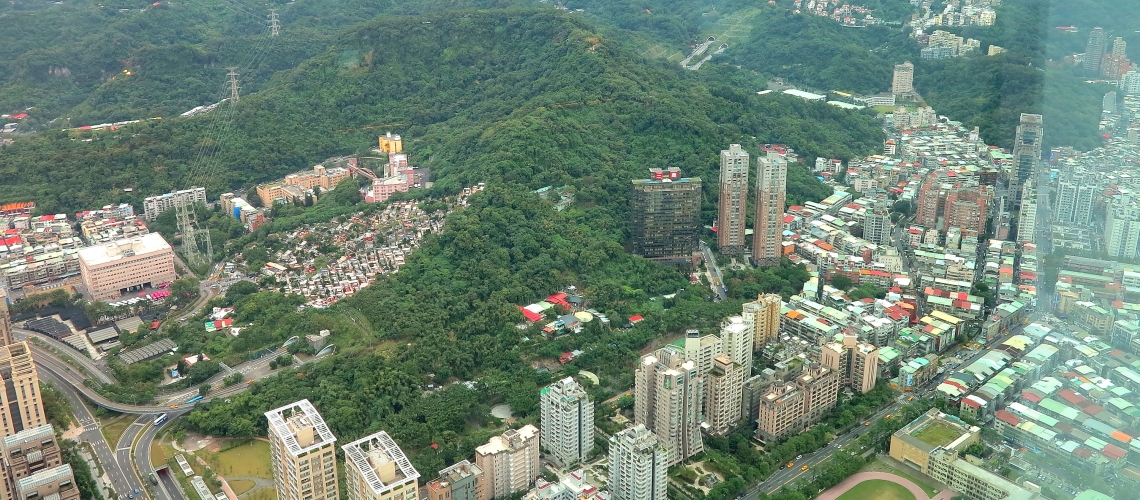I stood staring down from the 89th floor of Taipei 101, seeing the city for the first time at full scale and wondering how it all fit together.
From above you see Taipei as a metropolis of clustered grids, connected by wending highways, weaving somewhat inexplicably through forested mountains which swell at the edges of the silvery urban sprawl, forming the basin of a once vast lake, its waters dissipated centuries before.

If you know where to look, you can see and feel the history of the city, as plainly layered as the sediment of a sheer rock face. A Japanese street name hearkens to the Japanese occupation of 1895-1945. A cafe named Formosa recalls the “Beautiful Island” mapped by the Portugese in the 17th century. A small Protestant church suggests the Dutch traders who first converted the island’s aborigines. And, of course, Tai 101, itself, evokes the the Han Chinese who ousted the Dutch and created the dominant culture that we associate with Taiwan today.
The tallest building in the world when it was built in 2004 (since unseated by the Burj Khalifa in Dubai), Tai 101 was designed to be Taipei’s literal and figurative apex. Conceptually, Tai 101 is many things. It’s name is intended to evoke binary code and the date of the Western New Year, symbolizing progress and modernity, while its logo suggests three ancient Chinese coins, hearkening to Taiwan’s Chinese heritage. The structure of the building itself is a similar blend: a modern engineering feat of steel and glass meant to suggest the upward growth of bamboo or a stack of traditional Chinese money boxes. It was erected as a figurehead of prosperity and progress but also as a symbolic unification of Taiwan’s complicated connection with Chinese antiquity.

You ascend Tai 101 inside the pressurized cabin of one of the world’s fastest elevators. Created using the same titanium and high-resistance glass employed NASA, Tai 101’s bullet elevator rockets 84 storeys high in just under 40 seconds while LED constellations dance above your head. At the end of your ride, you exit into the 89th floor observatory: a glass panorama, from which you can peer downward as the city unfolds beneath your feet.
As I stood on the 89th floor, I tried to find Long Shan Temple, where I’d been the day before. There I’d been surrounded by both the faithful and the curious. I’d weaved between Japanese tourists, careful to avoid the pious old women whose black gowns lined the walls of the complex as they recited their prayers, myself taking in the many Taoist and Buddhist deities, some still standing after hundreds of years, others salvaged from smaller temples, toppled by the march of progress.
With my guide’s help, I could just make out the grounds of the National Palace Museum with its pagoda-style teal roofs. The next day I’d take in the sheer size of the building up close, along with its many treasures, secreted away during the destruction of Mao’s populist revolution by Chiang Kai-Shek. I’d see the famed jade cabbage, renowned for its delicate imitation of life; a progression of vases from plain clay to Ming and beyond; and—most impressive to me—an ivory sphere from the Qing dynasty, carved from a single tusk of ivory into 21 layers of concentric spheres, each independently moveable, each with intricate flourishes and radial grids.

After National Palace Museum, we’d travel into the mountains, to a place I couldn’t see from my 89th floor perch. Hidden among the forested elevations, we’d find the U-Theater. There my party and I would sit among the idyllic silence of the forest, listening to its founder, Ruo-Yu Liu explaining her path towards inner peace. Growing up in America, distantly aware of her Taiwanese roots but also profoundly estranged from a sense of her own history and identity, she traveled a circuitous path of self discovery, from theatrical gurus in New York, to years of silent meditation, to the art of Malaysian drumming. In Malaysia, she met her future husband, Chih-Chun Huang, who explained to Liu that Malaysian drumming was a preservation of a style of classical Chinese drumming which had faded from China centuries ago. So in that sense, it could be considered one of the purest forms of Chinese drumming still practiced. For Liu, this was a profound connection to the roots of her heritage. And so, when she decided to return to Taiwan, the home she’d never known, she brought it with her, adding yet another influence to the melting pot of the Taipei basin.
Together, we watched as the drummers erupted from the profound silence of the rustling leaves, their mallets hanging above their heads and crashing down in surging polyrhythms. I listened as the drums separated and reconvened, phasing out of sync with one another, complimenting each other, each rhythm finding its own way, whole together.

